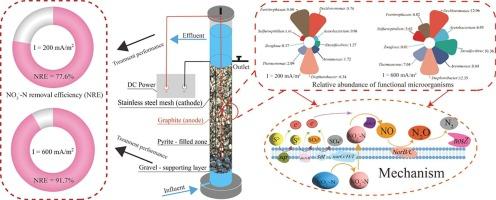微生物相互作用解释了电流密度对单一硫铁矿基电化学生物反应器在稳定阶段性能的影响机制
IF 13.2
1区 工程技术
Q1 ENGINEERING, CHEMICAL
引用次数: 0
摘要
黄铁矿自养反硝化(PAD)系统以其低碳、经济、环保等优点,在处理低碳氮比含氮废水方面受到广泛关注。微生物相互作用和代谢途径的改变深刻影响PAD系统的治疗效果。本研究构建了基于黄铁矿的电化学生物反应器(PEBR),并实现了长期稳定运行。当电流密度(CD)为600 mA/m2(进水NO3——N浓度为30 mg/L)、出水NH4+-N浓度小于3 mg/L时,NO3——N去除率达到94.59 %。在高CD条件下(>;600 mA/m2), SO42-和NO2——N浓度分别降至150和0.5 mg/L。PEBR性能的提高是由于优势属(如decchloromonas、Acetobacterium、Desulfovibrio和Arenimonas)的相互作用。Desulfovibrio和Acetobacterium的相对丰度分别从1.27 %和0.96 %(200 mA/m2)增加到10.36 %和6.93 %(600 mA/m2)。此外,胞外聚合物质(EPS)分泌的增加增强了PEBR的电子传递能力。Mantel试验表明,在电流刺激下,优势属(如Acetobacterium和Desulfovibrio)对反硝化和硫代谢有较大贡献。网络分析确定了与目标功能基因最相关的物种,进一步揭示了微生物在各种代谢途径中所起作用的差异。这些发现为PEBR中微生物共生关系的演替提供了一些见解,并指导了当前PEBR在实际应用中的使用。本文章由计算机程序翻译,如有差异,请以英文原文为准。

Microbial mutualisms explain the influencing mechanism of current density on the performance of a sole pyrite-based electrochemical bioreactor during the stable phase
With its low carbon, cost-effective, and environmentally friendly advantages, the pyrite-based autotrophic denitrification (PAD) system received widespread attention for treating low-C/N nitrogenous wastewater. Altered microbial mutualisms and metabolism pathways profoundly affect the treatment performance of the PAD system. In this study, a pyrite-based electrochemical bioreactor (PEBR) was constructed, and a stable long-term operation was achieved. The NO3–-N percentage removal peaked at 94.59 % at a current density (CD) of 600 mA/m2 (influent NO3–-N concentration: 30 mg/L) accompanied by an effluent NH4+-N concentration less than 3 mg/L. Under high CD conditions (> 600 mA/m2), the SO42- and NO2–-N concentrations were reduced to 150 and 0.5 mg/L, respectively. The improvement in PEBR performance was attributed to the mutualistic effects of dominant genera, like Dechloromonas, Acetobacterium, Desulfovibrio, and Arenimonas. The relative abundances of Desulfovibrio and Acetobacterium increased from 1.27 % and 0.96 % (200 mA/m2) to 10.36 % and 6.93 % (600 mA/m2), respectively. In addition, the increased secretion of extracellular polymeric substances (EPS) enhanced PEBR’s electron transport capacity. Mantel test revealed that under current stimulation, dominant genera (like Acetobacterium, and Desulfovibrio) contributed greatly to denitrification and sulfur metabolism. The network analysis identified species most related to target functional genes, further revealing differences in the roles that microorganisms played in various metabolism pathways. These findings provide some insights into the succession of microbial mutualistic relationships in PEBR and guide the use of current in the practical application of PEBR.
求助全文
通过发布文献求助,成功后即可免费获取论文全文。
去求助
来源期刊

Chemical Engineering Journal
工程技术-工程:化工
CiteScore
21.70
自引率
9.30%
发文量
6781
审稿时长
2.4 months
期刊介绍:
The Chemical Engineering Journal is an international research journal that invites contributions of original and novel fundamental research. It aims to provide an international platform for presenting original fundamental research, interpretative reviews, and discussions on new developments in chemical engineering. The journal welcomes papers that describe novel theory and its practical application, as well as those that demonstrate the transfer of techniques from other disciplines. It also welcomes reports on carefully conducted experimental work that is soundly interpreted. The main focus of the journal is on original and rigorous research results that have broad significance. The Catalysis section within the Chemical Engineering Journal focuses specifically on Experimental and Theoretical studies in the fields of heterogeneous catalysis, molecular catalysis, and biocatalysis. These studies have industrial impact on various sectors such as chemicals, energy, materials, foods, healthcare, and environmental protection.
 求助内容:
求助内容: 应助结果提醒方式:
应助结果提醒方式:


